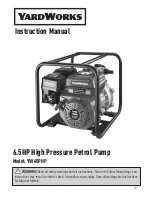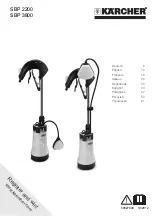
16
It is a good rule to carry out periodic checks in order to verify the proper operation of the unit.
OPERATION
1 month 4 month 6 month
Charging the water circuit.
x
Presence of bubbles in the water circuit.
x
Check if the safety and control devices work correctly
x
Check if there is oil leakage from compressor.
x
Check if there is water leakage from the hydraulic circuit.
x
Check the proper working of the flow switches.
x
Check that the crankcase electric heaters are properly supplied and functioning.
x
Clean the metallic filters of the hydraulic circuit.
x
Clean the finned coil by means of compressed air or water jet.
x
Check if all the terminals on the electric board as well as on the terminals of the compressor are
properly fixed.
x
Check the tightening of water connections.
x
Check the tightening and the balancing of the fan blades.
x
If the voltage is correct.
x
Check the Correct absorption.
x
Check the refrigerant charge.
x
Check the operating pressure, and superheat and sub-cooling
x
Check of the efficiency of circulation pump.
x
Check the expansion tank.
x
If the unit should be out of service for a long period, discharge water from the piping and from
heat exchanger. This operation is necessary if, during seasonal stoppages, ambient temperature is
expected to go down below the freezing point of the employed fluid.
x
10.1
ENVIRONMENTAL PROTECTION
According to the norms dealing with the use of depleting stratospheric ozone substances, it is forbidden to disperse refrigerants
fluids in the atmosphere. They have to be collected and delivered to the seller or to proper gathering points at the end of their
operating life. Refrigerant R410A is mentioned among controlled substances and for this reason it has to be subjected to the
mentioned norms.
A particular care is recommended during service operations in order to reduce as much as possible any
refrigerant loss.
11
DISPOSAL OF THE UNIT
Once the unit is arrived at the end of its life cycle and needs to be removed or replaced, the following operations are
recommended:
•
the refrigerant has to be recovered by trained people and sent to proper collecting centre;
•
compressors’ lubricating oil has to be collected and sent to proper collecting centre;
•
the frame and the various components, if not serviceable any longer, have to be dismantled and divided according to their
nature, particularly copper and aluminium, which are present in conspicuous quantity in the unit. These operations allow easy
material recover and recycling process, thus reducing the environmental impact.
The user is responsible of the proper disposal of this product, according to national regulations in the country of destination of the
appliance. For more information you should contact the installation company or local competent authority.
An incorrect decommissioning of the appliance may create serious environmental damage and endanger people’s
safety. Therefore, it’s recommended that the unit shall be disposed only by authorized persons and technical training
who have followed training courses recognized by the competent authorities.
It is required to follow the same precautions described in the previous paragraphs.
Pay special attention during the disposal operation of the refrigerant gas.
The illegal disposal of the product by the end user leads to the application of the penalties in accordance with the
law in the country where the disposal takes place.
The crossed bin symbol applied on the appliance indicates that the product, at the end of its useful life, must be
collected separately from other wastes.
















































